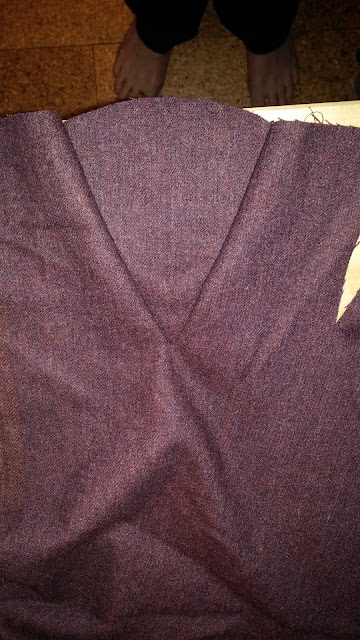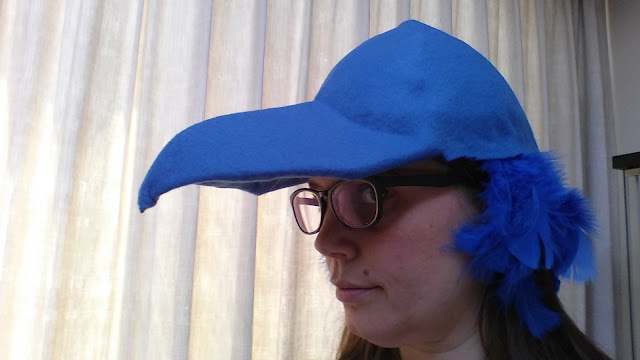So I got a text yesterday morning:
"Hmm.. I need a Muppet costume by tomorrow. Ideas?"
I was inspired by this
Instructable, though it's not a particularly detailed tutorial, and I wound up just using the general concept and winging it.
Materials: Shirt, hat, stiffened felt (I couldn't find craft foam?!?), feather boas (2), ~1 yd. fleece. Not pictured: individual feathers, 3" white and 2" black pompoms, remnant of black marabou boa.
 |
| This is not the shade of blue I would have preferred, but it was the one that I could find in feathers, fleece, and shirt. |
Rough out a beak out of paper, adjust, cut it out of felt. It's glued together and attached to the hat with hot glue. Most of the assembly is hot glue, which isn't a thing I would have predicted saying.
 |
| Excess brim removed. |
|
 |
| Begin positioning fabric over the form. Where there are pins now, there will soon be glue underneath |
 |
| Here I've glued along the ridge of the beak, and where the beak meets
the crown of the hat. Pins position the next bit, until I pull the
fabric back and glue the next bit |
 |
| Action shot! In general, I glued along the seams of the hat. |
 |
| Wrapping the fabric around the brim, trimming to shape |
 |
| Cut slits to work out the large folds of fabric |
 |
| Glue everywhere. |
And apparently that's all you get to see. The two halves come together and bridge the gap under the end of the beak, but you're just going to have to take my word for that.
 |
| Looks pretty good! Ah, you can see my high-tech head form in the
background: a small steel bowl balanced on top of an oatmeal canister. |
I also didn't document wrestling with the feathers, probably because it was really messy. The original Sam the Eagle has a row of feathers low around his head, curling out and downward. The feathers I was able to get are either split down the middle, causing them to spiral, or pretty darn straight. I used a spoon to gently curl the straight feathers, did a rough sort by length (so the shortest would be in front) and glued them to the edge of the hat before I glued the fabric down. They don't quite hang right, but I think they get the point across. I wound up working through the entire bag of crappy craft feathers, breaking a bunch of them while trying to curl. It was a huge mess. Feather bits everywhere. The cats loved it.

The bill is a little long, but I couldn't make it any shorter without cutting a *lot* of baseball cap brim...which I would do, if I were doing this over again. I was needlessly intimidated. I'm also not giddy about how the fabric went over the crown of the cap. It has a little bit of a peak over the button, and Sam's head is very flat on top. Oh, well.
While the length *is* a problem, I can position the eyes to make the bill look a little shorter.
 |
| The eyes are stacked pom-poms, with little sausages of fleece to make the lower lids/bags. |
I wanted to build the eyes completely, separately from the rest of the hat. I needed to be able to see what they would ultimately look like, to position them appropriately, so I bult them on a base of the felt.
 |
| 3" semicircles of felt to use as a base., 4" x 6" strips of fleece rolled up a little along one edge. |
 |
| The corners of the rolled piece are glued to the corners of the
semicircle, and (when flipped over) the roll itself is massaged into a
good shape, and the raw edges cut off. |
 |
| I tried smashing the pompoms flat with books to avoid the snowman
effect, but it really didn't work. So instead, I actually took a NEEDLE
and THREAD and stitched through all layers, pulling the thread tight
and tying it off. |
 |
| After stitching, and before. |
 |
Finally, eyes glued in place and topped off with a bit of black marabou boa leftover from another project. |
I didn't think to document building the wings. They're just sleeves, attached at the front and back, meant to be worn over the blue t-shirt. I ran one boa along top edge of both sleeves and across the front, the other went about 2" below the first in the back, and (obviously) across the back.
Here's where it stood, at five o'clock, six hours after I returned from the fabric store.
We weren't sure what to do with the bottom half, though. I suggested shorts and flipflops, to represent the puppeteer, but then we found star-spangled swim trunks. By some fluke, I had chicken leg socks (intended to be a gift for my mom, but she can wait for another pair), and the American flag sandals were the obvious finish to the outfit. Once home from the shopping spree, I decided making the lower jaw wouldn't be that hard, and, in fact, it wasn't.
It is possible that Sam the Eagle is the favorite Muppet of the guest of honor of the Muppet-themed going-away party this is for. I've told the recipient that he's welcome to give the costume to her; it's hilarious, and I'm proud of it, but I *don't* want to store the damn thing! Ugh, the feathers!






















































